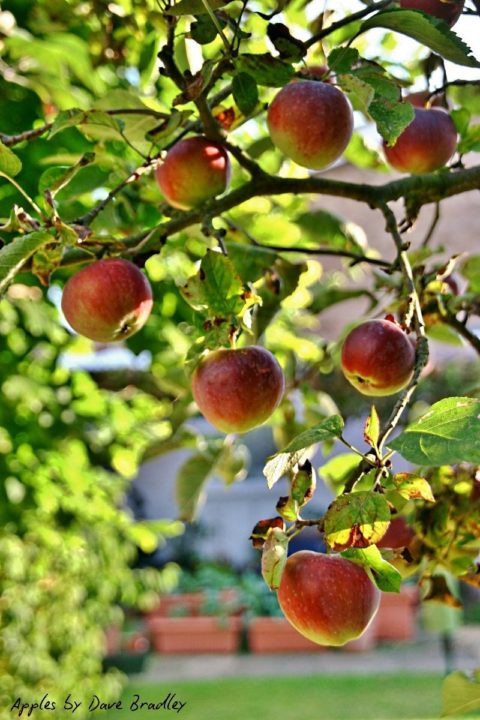…no, not that one…not that one either…just the fruit.
Now, our dog is a fruitarian. Well, actually that’s not strictly true, she’s a carnivore, a coprophyte, a toastaholic, a pescatarian, a big fan of blackberries, which she nibbles from the brambles, she’s a sloe learner too, similarly nibbling off the tiny, plum-like produce of the blackthorn bushes. In fact, I should just confess, she’s a labrador. She will eat anything, and anything foul-smelling she doesn’t eat, she will roll in. Labrador guardians will know exactly what I’m talking about. As a puppy she dug up and attempted to devour all the heathers we’d planted in the garden, she tried to tear the painted, wooden skirting boards from the kitchen walls and had a good go at the plastic handle of of my half-decent (but freebie) carving knife.
And, she likes apples. Whether we’re walking through a woodland with windfall crab apples or the little red numbers that fall from our tree in the garden, she will munch them down, seeds and all. If any of the family, their friends, just anyone in her vicinity is eating and apple (or toast), she will sit expectantly until those in the know throw her their core. Only stuff she doesn’t eat are grapes, garlic, onions and chocolate (but that’s not her choice, that’s us avoiding her being poisoned)
Okay, so that’s the backstory. This year, our apple tree is overburdened with fruit, the lower branches are bent under the weight, almost touching the lawn. They are, needless to say, very much at nose height for a canine malophile, who was caught, not one hour ago, selecting a shiny red specimen and tugging it from its arboreal offshoot. Caught red-pawed, my wife verbally chastised the dog and then proceeded to harvest the remnants of the low-hanging fruit.

For the next hour or so, I could hear the food processor with its “juicer” grinding away those apples to relieve them of their acidic liquor and into the pan it went. Not surprisingly it having taken on the brown hue of apple exposed to the air and having undergone enzymatic browning. Now, the curious thing is, my wife added some sugar and ascorbic acid (vitamin C) to this simmmering brew. The addition of the vitamin C visually reversed the browning and the pan is now gently bubbling with fifty shades of green…not even a hint of beige to be seen.
So, what’s going on? As a lowly chemist, I’d always assumed that the oxidative and enzymatic degradation of apples to that brown colour was an irreversible biochemical process. Indeed, an apple expert tells me this indeed the case, the PPO is kept separate from phenolics in a health uncut and unbruised apple; discussed in detail on the Okanagan Specialty Fruits. Obviously, you can use lemon or lime juice to stave it off (ascorbic, anti-scurvy, acid, you see?) but once it has gone over to the brown side, I’d assumed (again, as a lowly chemist) that that was it.
A quick Google, with their simplified, serif-free new logo, brought up a paper from a journal I’d not heard of, but with the obvious title of HortScience. This is promising. In a paper entitled, “Enzymatic Browning, Polyphenol Oxidase Activity, and Polyphenols in Four Apple Cultivars: Dynamics during Fruit Development” (even more promising), a team at the University of Santa Catarina in Brazil have this to say:
Enzymatic browning is one of the most important reactions that occur in fruits and vegetables, usually resulting in negative effects on color, taste, flavor, and nutritional value. The reaction is a consequence of phenolic compounds' oxidation by polyphenol oxidase (PPO), which triggers the generation of dark pigments. This is particularly relevant for apples, which are rich in polyphenols and highly susceptible to enzymatic browning.
As plant secondary metabolites, phenolic compounds produce colours, astringency, flavour, and have nutritional qualities in fruits and vegetables. Now, I should have known, and maybe I did in my past life as a lowly chemist, these compounds are perhaps acting as indicators of oxidation state and thus, as with many other indicator compounds will exist in equilibrium and thus oscillate between colours (or colourless states) depending on the concentrations of other chemicals (acids, alkalis) resident in the mix. Further Googling revealed that various people who put sliced apple in their kids’ school lunchboxes discovered that a sprinkling of vitamin C protected the slices from browning, but at least one “mom” discovered that it reversed the browning, even after a day abandoned in a lunchbox…making it fine for eating as an enforced, after-school snack for “Junior”…
There are countless web pages with tips for malophiles with the knowledge to keep their beloved fruit of life from turning brown. But, of course, you might soon be able to buy genetically modified apples approved early in 2015 by the US Department of Agriculture that have the gene for that PPO enzyme disabled, which means you should never need to just add vitamin C to keep them whiter than white, or is that greener than green?
The original condensed version of this article appeared as one of my twice-monthly Comments in the journal Materials Today.